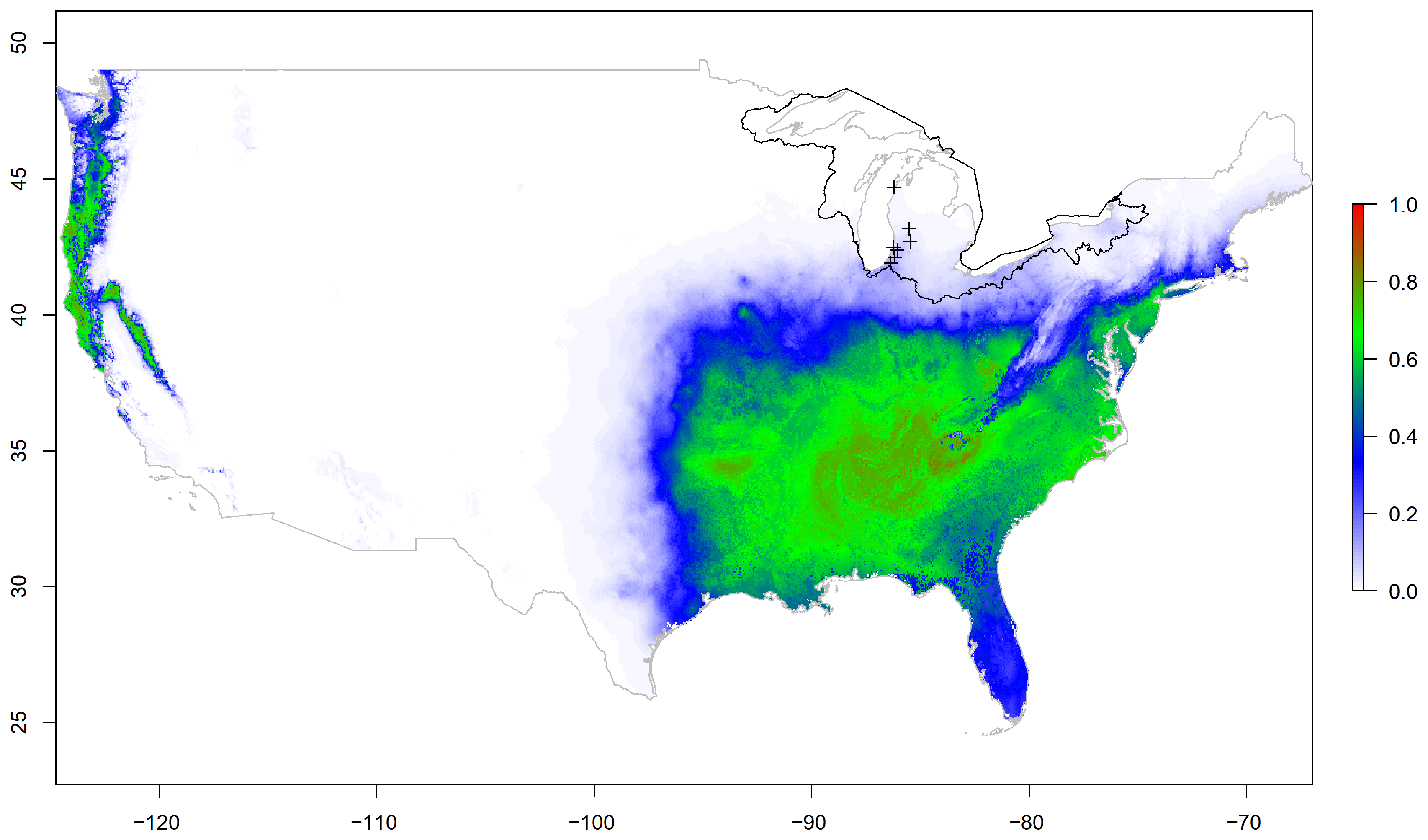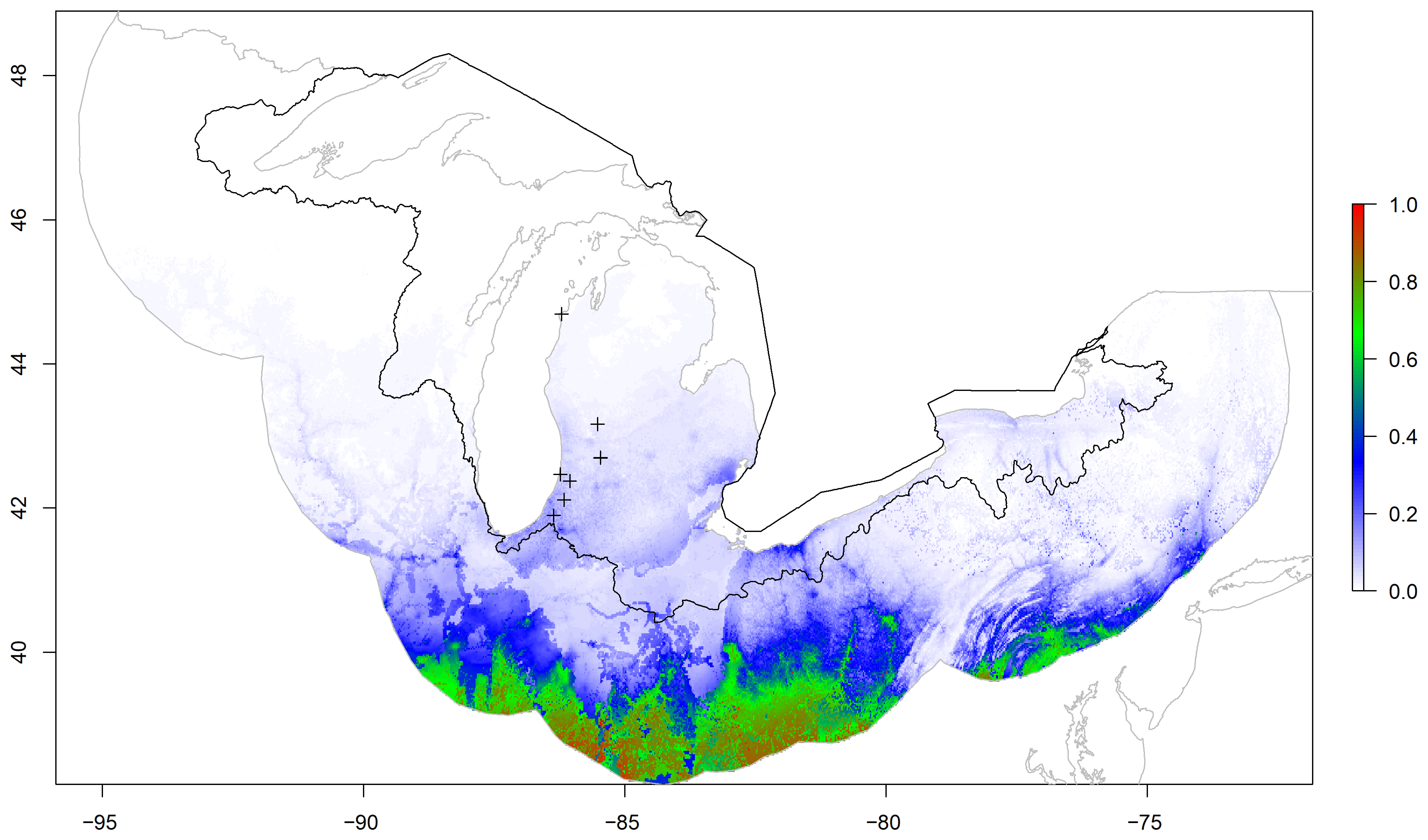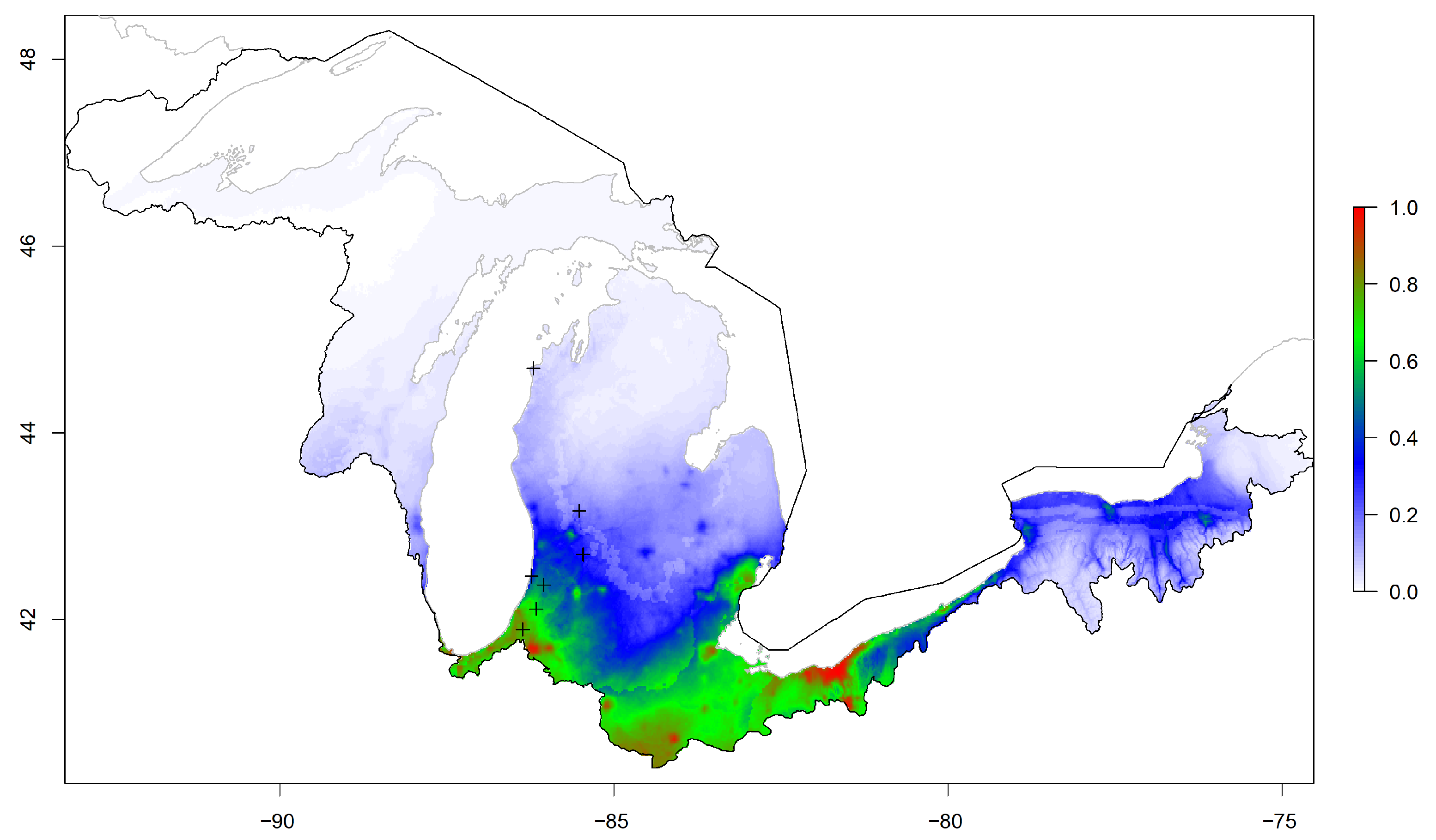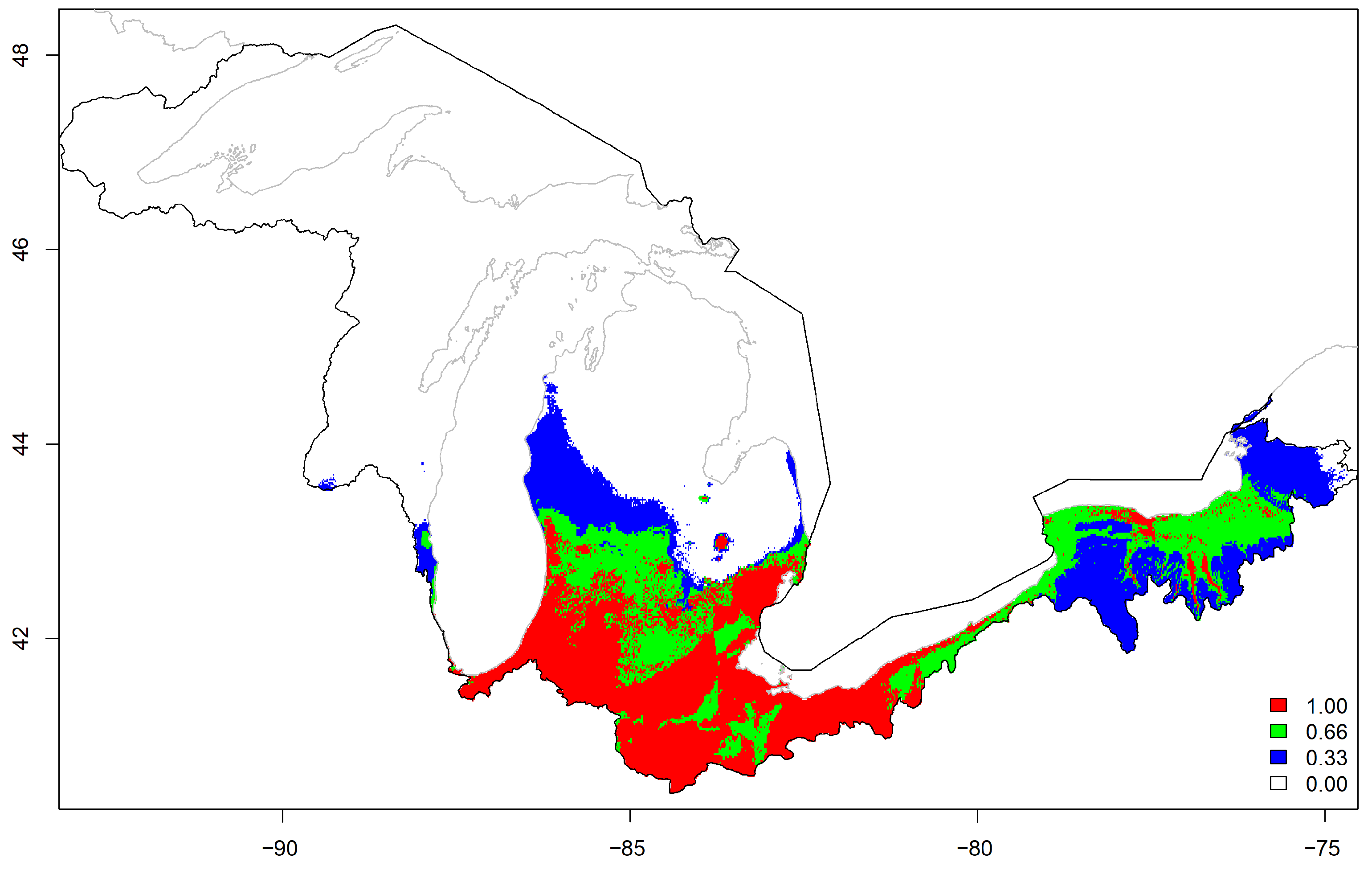Predictive Modeling of Kudzu (Pueraria montana) Habitat in the Great Lakes Basin of the United States
Abstract
1. Introduction
2. Results
3. Discussion
4. Materials and Methods
Supplementary Materials
Author Contributions
Funding
Institutional Review Board Statement
Informed Consent Statement
Data Availability Statement
Acknowledgments
Conflicts of Interest
References
- Millennium Ecosystem Assessment. Ecosystems and Human Well-Being: Biodiversity Synthesis; World Resources Institute: Washington, DC, USA, 2005. [Google Scholar]
- Pimentel, D.; Zungia, R.; Morrison, D. Update on the environmental and economic costs associated with alien-invasive species in the United States. Ecol. Model 2005, 52, 273–288. [Google Scholar] [CrossRef]
- Lodge, D.M.; Williams, S.; MacIssac, H.J.; Hayes, K.R.; Leung, B.; Reichard, S.; Mack, R.N.; Moyle, P.B.; Smith, M.; Andow, D.A.; et al. Biological invasions: Recommendations for US policy and management. Ecol. Appl. 2006, 16, 2035–2054. [Google Scholar] [CrossRef]
- Lindgren, C.J.; Castro, K.L.; Coiner, H.A.; Nurse, R.E.; Darbyshire, S.J. The biology of invasive alien plants in Canada. 12. Pueraria montana var. lobata (Willd.) Sanjappa & Predeep. Can. J. Plant Sci. 2013, 93, 71–95. [Google Scholar]
- Brown, K.H. Fair Japan: Japanese gardens at American World’s Fairs, 1876–1940. SiteLINES 2008, 4, 13–16. [Google Scholar]
- Guertin, P.J.; Denight, M.L.; Gebhart, D.L.; Nelson, L. Invasive species biology, control, and research. Part 1: Kudzu (Pueraria montana). Engineer Research and Development Center. US Army Corps of Engineers. Available online: https://apps.dtic.mil/sti/pdfs/ADA491410.pdf (accessed on 14 November 2022).
- Pieters, A.J. Kudzu, a Forage Crop for the Southeast; Leaflet No. 91; U.S. Department of Agriculture: Washington, DC, USA, 1932.
- Winberry, J.J.; Jones, D.M. Rise and decline of the “miracle vine”: Kudzu in the southern landscape. Southeast Geogr. 1973, 13, 61–70. [Google Scholar] [CrossRef]
- Callen, S.T.; Miller, A.J. Signatures of niche conservatism and niche shift in the North American kudzu (Pueraria montana) invasion. Divers. Distrib. 2015, 21, 853–863. [Google Scholar] [CrossRef]
- EDDMapS. Early Detection & Distribution Mapping System. The University of Georgia—Center for Invasive Species and Ecosystem Health. Available online: http://www.eddmaps.org/ (accessed on 14 November 2022).
- Boyette, C.D.; Walker, H.L.; Abbas, H.K. Biological control of kudzu (Pueraria lobata) with an isolate of Myrothecium verrucaria. Biocontrol Sci. Technol. 2002, 12, 75–82. [Google Scholar] [CrossRef]
- Mitich, L.W. Intriguing World of Weeds. Kudzu [Pueraria lobata (Willd.) Ohwi]. Weed Technol. 2000, 14, 231–235. [Google Scholar] [CrossRef]
- Britton, K.O.; Orr, D.; Sun, J. Kudzu. In Biological Control of Invasive Plants in Eastern United States; Van Driesche, R., Lyon, S., Blossey, B., Hoddle, M., Reardon, R., Eds.; USDA Forest Service: Morgantown, WV, USA, 2002; pp. 325–330. [Google Scholar]
- Forseth, I.N., Jr.; Innis, A.F. Kudzu (Pueraria montana): History, physiology, and ecology combine to make a major ecosystem threat. Crit. Rev. Plant Sci. 2004, 23, 401–413. [Google Scholar] [CrossRef]
- Munger, G.T. Pueraria montana var. lobata. Fire Effects Information System. USDA Forest Service, Rocky Mountain Research Station, Fire Sciences Laboratory. Available online: https://www.fs.usda.gov/database/feis/plants/vine/puemonl/all.html (accessed on 14 November 2022).
- Abramovitz, J.N. Pueraria lobata Willd. (OHWI), Kudzu: Limitations to Sexual Reproduction. Master’s Thesis, University of Maryland, College Park, MD, USA, 1983. [Google Scholar]
- Bentley, K.E.; Mauricio, R. High degree of clonal reproduction and lack of large-scale geographic patterning mark the introduced range of the invasive vine, kudzu (Pueraria montana var. lobata), in North America. Am. J. Bot. 2016, 103, 1499–1507. [Google Scholar]
- Coiner, H.A.; Hayhoe, K.; Ziska, L.H.; Van Dorn, J.; Sage, R.F. Tolerance of subzero winter cold in kudzu (Pueraria montana var. lobata). Oecologia 2018, 187, 839–849. [Google Scholar] [CrossRef] [PubMed]
- USDA. Plant Hardiness Zone Map. Agricultural Research Service, U.S. Department of Agriculture. Available online: https://planthardiness.ars.usda.gov/ (accessed on 18 November 2022).
- NOAA. Climate Data Online: Benzie County, MI (FIPS:26019). National Centers for Environmental Information. Available online: https://www.ncdc.noaa.gov/cdo-web/datasets/GHCND/locations/FIPS:26019/detail (accessed on 14 November 2022).
- Guisan, A.; Thuiller, W. Predicting species distribution: Offering more than simple habitat models. Ecol. Lett. 2005, 8, 993–1009. [Google Scholar] [CrossRef] [PubMed]
- Elith, J.; Graham, C.H.; Anderson, R.P.; Dudík, M.; Ferrier, S.; Guisan, A.; Hijmans, R.J.; Huettmann, F.; Leathwick, J.R.; Lehmann, A.; et al. Novel methods improve prediction of species’ distributions from occurrence data. Ecography 2006, 29, 129–151. [Google Scholar] [CrossRef]
- Gastón, A.; García-Viñas, J.I. Modelling species distributions with penalized logistic regressions: A comparison with maximum entropy models. Ecol. Model 2011, 222, 2037–2041. [Google Scholar] [CrossRef]
- Baldwin, R.A. Use of maximum entropy modeling in wildlife research. Entropy 2009, 11, 854–866. [Google Scholar] [CrossRef]
- Bradley, B.A.; Wilcove, D.S.; Oppenheimer, M. Climate change increases risk of plant invasion in the Eastern United States. Biol. Invasions 2010, 12, 1855–1872. [Google Scholar] [CrossRef]
- Vázquez, D.P. Exploring the relationship between niche breadth and invasion success. In Conceptual Ecology and Invasion Biology; Cadotte, M.W., McMahon, S.M., Fukami, T., Eds.; Springer: Dordrecht, NL, USA, 2006; pp. 307–322. [Google Scholar]
- Freeman, E.A.; Moisen, G.G. A comparison of the performance of threshold criteria for binary classification in terms of predicted prevalence and kappa. Ecol. Model 2008, 217, 48–58. [Google Scholar] [CrossRef]
- Pörtner, H.-O.; Roberts, D.C.; Tignor, M.; Poloczanska, E.S.; Mintenbeck, K.; Alegría, A.; Craig, M.; Langsdorf, S.; Löschke, S. Climate Change 2022: Impacts, Adaptation and Vulnerability. In Contribution of Working Group II to the Sixth Assessment Report of the Intergovernmental Panel on Climate Change; Cambridge University Press: Cambridge, UK; New York, NY, USA, 2022. [Google Scholar]
- Widrlechner, M.P.; Daly, C.; Keller, M.; Kaplan, K. Horticultural applications of a newly revised USDA Plant Hardiness Zone Map. HortTechnology 2012, 22, 6–19. [Google Scholar] [CrossRef]
- Widrlechner, M.P. Environmental analogs in the stress-tolerant landscape plants. J. Arboric. 1994, 20, 114–119. [Google Scholar] [CrossRef]
- Geerts, S.; Mashele, B.V.; Visser, V.; Wilson, J.R.U. Lack of human-assisted dispersal means Pueraria montana var. lobata (kudzu vine) could still be eradicated from South Africa. Biol. Invasions 2016, 18, 3119–3126. [Google Scholar]
- Ehrlén, J.; Eriksson, O. Dispersal limitation and patch occupancy in forest herbs. Ecology 2000, 81, 1667–1674. [Google Scholar] [CrossRef]
- Fick, S.E.; Hijmans, R.J. WorldClim 2: New 1-km spatial resolution climate surfaces for global land areas. Int. J. Climatol. 2017, 37, 4302–4315. [Google Scholar] [CrossRef]
- Dewitz, J. National Land Cover Database (NLCD) 2019 Products. US Geological Survey. Available online: https://doi.org/10.5066/P9KZCM54 (accessed on 15 November 2022).
- Ruefenacht, B.; Finco, M.V.; Nelson, M.D.; Czaplewski, R.; Helmer, E.H.; Blackard, J.A.; Holden, G.R.; Lister, A.J.; Salajanu, D.; Weyermann, D.; et al. Conterminous U.S. and Alaska forest type mapping using Forest Inventory Analysis data. Photogramm. Eng. Remote Sens. 2008, 74, 1379–1388. [Google Scholar] [CrossRef]
- Horton, J.D. The State Geologic Map Compilation (SGMC) Geodatabase of the Conterminous United States (ver. 1.1, August 2017), U.S. Geological Survey. Available online: https://www.sciencebase.gov/catalog/item/5888bf4fe4b05ccb964bab9d (accessed on 15 November 2022).
- Hijmans, R.J.; Phillips, S.; Leathwick, J.; Elith, J. Dismo: Species Distribution Modeling. R Package Version 1.3-9. Available online: https://cran.r-project.org/packages=dismo (accessed on 11 November 2022).
- Merow, C.; Smith, M.J.; Silander, S.A., Jr. A practical guide to MaxEnt for modeling species distributions: What it does, and why inputs and settings matter. Ecography 2013, 36, 1058–1069. [Google Scholar] [CrossRef]
- Sokal, R.R.; Rohlf, F.J. Biometry: The Principles and Practice of Statistics in Biological Research, 4th ed.; W.H. Freeman and Company: New York, NY, USA, 2012. [Google Scholar]
- Midwest Invasive Species Information Network. Michigan State University. Available online: https://www.misin.msu.edu/ (accessed on 11 November 2022).
- Pembury Smith, M.Q.R.; Ruxton, G.D. Effective use of the McNemar test. Behav. Ecol. Sociobiol. 2020, 74, 133. [Google Scholar] [CrossRef]
- Chicco, D.; Jurman, G. The advantages of the Matthews correlation coefficient (MCC) over F1 score and accuracy in binary classification evaluation. BMC Genom. 2020, 21, 6. [Google Scholar] [CrossRef]





| Variable | National | Regional | Basin |
|---|---|---|---|
| Forest | 1.3 | 4.6 | 0.0 |
| Geology | 0.2 | 3.6 | 1.0 |
| NLCD | 0.0 | 2.2 | 7.4 |
| Precipitation | 81.3 | 0.4 | 1.2 |
| Temperature | 17.2 | 89.3 | 90.5 |
| Area (km2) | 7.80 × 106 | 1.12 × 106 | 4.48 × 105 |
| Kudzu Locations | 4263 | 164 | 10 |
| Background | 10,000 | 1436 | 574 |
| AUC | 0.795 | 0.906 | 0.900 |
Disclaimer/Publisher’s Note: The statements, opinions and data contained in all publications are solely those of the individual author(s) and contributor(s) and not of MDPI and/or the editor(s). MDPI and/or the editor(s) disclaim responsibility for any injury to people or property resulting from any ideas, methods, instructions or products referred to in the content. |
© 2023 by the authors. Licensee MDPI, Basel, Switzerland. This article is an open access article distributed under the terms and conditions of the Creative Commons Attribution (CC BY) license (https://creativecommons.org/licenses/by/4.0/).
Share and Cite
Kovach-Hammons, A.M.; Marshall, J.M. Predictive Modeling of Kudzu (Pueraria montana) Habitat in the Great Lakes Basin of the United States. Plants 2023, 12, 216. https://doi.org/10.3390/plants12010216
Kovach-Hammons AM, Marshall JM. Predictive Modeling of Kudzu (Pueraria montana) Habitat in the Great Lakes Basin of the United States. Plants. 2023; 12(1):216. https://doi.org/10.3390/plants12010216
Chicago/Turabian StyleKovach-Hammons, Ashley M., and Jordan M. Marshall. 2023. "Predictive Modeling of Kudzu (Pueraria montana) Habitat in the Great Lakes Basin of the United States" Plants 12, no. 1: 216. https://doi.org/10.3390/plants12010216
APA StyleKovach-Hammons, A. M., & Marshall, J. M. (2023). Predictive Modeling of Kudzu (Pueraria montana) Habitat in the Great Lakes Basin of the United States. Plants, 12(1), 216. https://doi.org/10.3390/plants12010216





